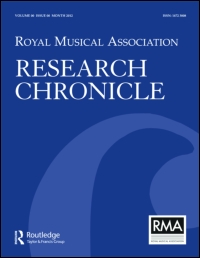Article contents
Annotated Membership Lists of the Venetian Instrumentalists’ Guild, 1672–1727
Published online by Cambridge University Press: 01 January 2020
Extract
Naval records seem an unlikely source of information about musicians, but many unlikely things happened in Venice. It has recently come to light that Venetian craft guilds served as conscription agencies for the Armada and revenue agencies for the Republic. Hence, one of the things that is to be found among naval records in the Venetian State Archives is a series of reports from the instrumentalists’ guild (‘arte di sonadori’) concerning its membership. The surviving documents relate principally to the period from 1672 to 1727, although the alliance of guild and government was operative for several centuries. The reports of membership are notably lengthy (guild membership seems to have been on average about 170) and frequently include members’ ages, knowledge of which was vital to estimates of potential naval strength. In the following pages the reader will find an annotated listing of names and ages representing the contents of the seven membership lists in the fascicle labelled ‘Sonadori’ in Bus ta 553 of the archival source ‘Milizia da Mar’. No corresponding records of a guild of ‘cantori’ have come to light.
- Type
- Research Article
- Information
- Copyright
- Copyright © Royal Musical Association, 1971
References
1 The author here expresses her gratitude to the Venetian State Archives for permission to publish this material, to Richard T. Rapp for calling attention to the historical value of these documents, and to the University of Pittsburgh for a research grant that permitted extensive examination of these documents.Google Scholar
2 The instrumentalists’ guild is not to be confused with the Società Santa Cecilia, a musicians’ guild founded in 1685 by Partenio and others. The guild of St. Cecilia had no official connection, so far as is known, with the government of the Republic and functioned rather like a fraternity. Its membership was limited to 100 and included singers as well as instrumentalists. In its charter [recorded in the Biblioteca Marciana Ms. It. VII 2447 (10056) ff. 3–6] the guild of St. Cecilia addresses itself to ‘professori di musica’ and states that one of its major functions is to be the provision of adequate musical honour for its patron on Her feast day. The guild of St. Cecilia was based at the church of San Martino, Partenio's parish church.Google Scholar
1 The guild appears to have had a permanent association with the church of San Silvestro. Entries similar to this one occur in the other accounts of this file. This association suggests that the instrumentalists’ guild is the organization referred to by Henry Prunières in a footnote on p. 84 of Claudio Monteverdi (Paris, 1931).Google Scholar
2 Nothing is known about the prohibition of dances, though such a ban is at least plausible when one considers how few dance suites appeared in Venice between the third and the final decades of the seventeenth century.Google Scholar
1 In all events, document C derives from a year not very remote from 1708, a year about which much is known through Francesco Caffi's enterprising study, Storia della musica sacra nella gia Cappella Ducale di S. Marco in Venezia dal 1318 al 1797 (Venice, 1854–58), II, 61. Caffi enumerates 23 instrumentalists employed at San Marco in 1708. Of these, 18 are also named on document C. Those present in Caffi's listing but absent from document C are Francesco Parma (theorbo), Don Gerolamo Cortini (cornett), Onofrio Penati (oboe), Francesco Valletti (viola), and Giovanni Venerando (double bass). It might be noted that Francesco Parma was hired at San Marco in 1675 but is not mentioned on document B. Penati was a well-known oboist active at San Marco until 1748; nonetheless, no mention of him occurs in guild records.Google Scholar
A more comprehensive account of instrumental affairs at San Marco in the early eighteenth century that incorporates most of Caffi's material is available in Denis Arnold's article, ‘Orchestras in Eighteenth-Century Venice, ’ The Galpin Society Journal, XIX (1966).Google Scholar
The year 1708 does not have an exceptional significance but it happens to be a year in which detailed records were kept. These may be found in the archival source BSM 91, Proc. 208, Fasc. 1, which is itself based largely on the Chiesa Actorum series.Google Scholar
1 The one biography in conflict with this estimate is that of Giuseppe Boniventi, who is named on D but was ostensibly employed in Baden-Durlach from 1712 to 1721. To try to accommodate Boniventi's example by presuming that D is earlier than 1712 requires either the assumption that C dates from 1705 (and D from 1711), the arguments against which are myriad, or that D itself dates from 1705, in which case some of the younger persons named on document E would have had to be guild members in early childhood.Google Scholar
- 1
- Cited by




